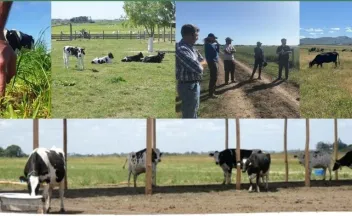
Instituto Nacional de Investigación Agropecuaria



In the last decade, the evolution of herbicide-resistant weeds, especially barnyardgrass (Echinochloa crus-galli (L.) Beauv.), to acetolactate synthetase (ALS) inhibitor herbicides, has accelerated. This research focused on the analysis of the new cultivars ACCase herbicide tolerance. Complete randomized blocks designed were used in two regions, using two new cultivars and early seeding dates.

ABSTRACT.- The development of metrics to assess the sustainability of food production systems is vital for achieving sustainable global agri-food systems. Nitrogen use efficiency (NUE), defined as the ratio of nitrogen (N) in food outputs to total N inputs, is a key indicator of resource efficiency in crop and livestock systems.

ABSTRACT.- In Brazil, CNS diseases in equids were little known until the 1980s. Since then, several diagnostic laboratories have been operating in different universities, initially in the South and Southeast regions and, later, in the Central-West, Northeast and North regions. However, the knowledge accumulated from the diagnoses of nervous system diseases of equids made at these institutions over the years has not been reviewed comprehensively, and many papers are published in Portuguese.

This research project was focused in minimizing inorganic arsenic levels in polished rice grain while maintaining crop yield and water productivity of the most planted Indica cultivar in Uruguay, INIA Merin. Two experiments were conducted during seasons 2018-2019 and 2019-2020.

In Uruguay, flooded rice historically rotated with perennial pastures (mix of grasses and legumes) for livestock production. Business as usual consisted basically in two years of rice crops followed by two to four years of grazed pastures. This allowed increased yields, diversified incomes, preserved natural resources, and minimized the use of pesticides and fertilizers.

The occurrence of climate variations known as ENSO phases are caused by anomalies in ocean surface temperature in the so-called Niño 3.4 region in the Central Equatorial Pacific. These anomalies are officially used by NOAA (U.S. National Oceanic and Atmospheric Administration) to define whether there is a probability of occurrence of a La Niña, El Niño or neutral phase with global impact. In Uruguay, South America, the impact of climatic variations associated with ENSO phases on agricultural and pasture production is well known.